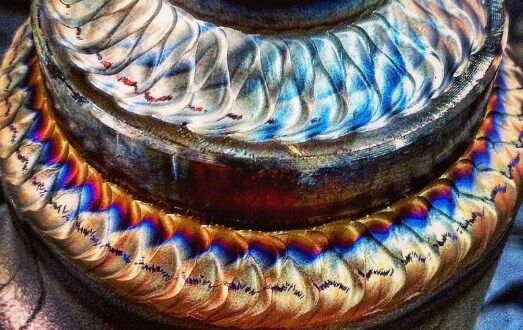In the world of welding, the term "fish scale" refers to a specific weld bead appearance characterized by overlapping semicircles or ripples, resembling the scales of a fish. While sometimes considered a desirable aesthetic finish, achieving a consistent and uniform fish scale weld with Argon Arc Welding (TIG) requires skill, precision, and a deep understanding of the process. This article from Megmeet Welding Technology delves into the art and science of creating these distinctive welds, focusing on the techniques and considerations involved.
We will explore why welders aim for this pattern, the specific techniques used with Argon Arc Welding (GTAW/TIG), common challenges, and how to overcome them. We'll also include a helpful comparison table outlining the key elements for achieving a good fish scale weld.

I. Why "Fish Scale" Welds? Aesthetics Meets Function?
While not a formal welding defect, the "fish scale" appearance is often sought after in certain applications for both aesthetic and functional reasons:
Aesthetics: A well-executed fish scale pattern can indicate a skilled welder and a controlled process, often seen in artistic welding, exposed structural components, or stainless steel fabrication, where visual appeal is important.
Weld Quality (Implied): A consistent and even fish scale pattern often suggests that the welder maintained a steady hand, controlled heat input, and achieved proper penetration and fusion, indirectly indicating a quality weld (though appearance alone is not a guarantee of structural integrity).
Weld Profile Control: The overlapping ripples can help control the weld bead profile, especially on horizontal or overhead welds, preventing the weld from sagging.
However, it's crucial to understand that the "fish scale" is a result of a specific manipulation of the welding torch and filler metal, not an inherent property of the weld itself. Overly pronounced or inconsistent scales can sometimes indicate issues like excessive torch movement or uneven heat input.
II. Achieving the "Fish Scale" with Argon Arc Welding (TIG)
Argon Arc Welding (TIG), known for its precision and control, is the ideal process for creating distinct and uniform fish scale welds. The precise control over the arc and filler metal allows welders to manipulate the molten puddle and create the desired overlapping ripple effect.
Here's a breakdown of the key elements and techniques:
1. Equipment Setup and Preparation
TIG Welder: A high-quality TIG machine with stable current control is essential. Megmeet Welding Technology offers advanced TIG welders designed for precise arc control, crucial for intricate work like fish scale welds.
Tungsten Electrode: Select the appropriate size and type of tungsten for the material and current. Sharpen the tungsten to a clean point for precise arc focus.
Filler Metal: Choose the correct filler metal for the base metal and application. Use clean, high-quality filler rod.
Shielding Gas: Use 100% Argon (or an appropriate Argon-Helium mix for thicker materials) at the correct flow rate to ensure proper shielding.
Material Preparation: Thoroughly clean the base metal to remove all contaminants (oil, grease, rust, etc.). This is crucial for a clean, consistent weld.
2. The Welding Technique
The "fish scale" effect is primarily achieved through a specific torch and filler rod manipulation technique:
Arc Initiation: Start the arc at the beginning of the joint.
Puddle Formation: Establish a molten puddle of the desired size.
Filler Metal Addition: Dip the filler rod into the leading edge of the puddle, adding a small amount of material.
Torch Movement (Forward): Move the torch slightly forward, creating the initial ripple.
Torch Movement (Backward/Dipping): This is where the "fish scale" is formed. As you move forward, simultaneously move the torch slightly backward over the solidified or semi-solidified ripple, and often dip the filler rod into the puddle again at the leading edge of the previous ripple. This overlapping movement creates the characteristic scale appearance.
Rhythm and Consistency: The key to a uniform fish scale is a consistent rhythm and repeatable movement of the torch and filler rod. The speed of movement, the amount of filler metal added with each dip, and the overlap of the ripples determine the size and spacing of the scales.
Arc Length Control: Maintain a short and consistent arc length for better control and focus of the heat.
Travel Speed: The travel speed should be coordinated with the torch and filler rod manipulation to create evenly spaced ripples.
Electrode Angle: Maintain a consistent electrode angle to direct the heat and control the puddle flow.
3. Fine-Tuning for Different Materials and Thicknesses
The technique may need slight adjustments based on the material and its thickness:
Aluminum: Due to its high thermal conductivity, aluminum requires a faster travel speed and potentially a higher heat input to maintain a consistent puddle and prevent burn-through. The fish scale might appear more spread out.
Stainless Steel: Stainless steel retains heat more, requiring a slower travel speed and potentially less heat input to avoid overheating and distortion. The fish scales can be more defined.
Thicker Materials: May require higher amperage and potentially a slight weaving motion in addition to the dipping technique to ensure proper penetration and fill.
Thinner Materials: Require very precise control over heat input to prevent burn-through. The fish scales might be smaller and closer together.
III. Common Challenges When Aiming for "Fish Scale" Welds and Solutions
While the fish scale is a visual goal, certain issues can arise when attempting to achieve it:
Inconsistent Scale Size and Spacing: Cause: Uneven rhythm and movement of the torch and filler rod. Solution: Practice maintaining a consistent rhythm and focus on repeatable hand movements.
Overlapping Scales are Too Pronounced or Not Enough: Cause: Incorrect overlap in the backward/dipping motion. Solution: Adjust the backward movement and the timing of filler rod dips to control the amount of overlap.
Lack of Fusion Between Scales: Cause: Moving too fast, insufficient heat input, or inadequate overlap. Solution: Slow down travel speed slightly, increase heat input, and ensure sufficient overlap in the dipping motion.
Porosity Within the Scales: Cause: Contaminated material, inadequate shielding gas, or improper filler rod dipping (introducing air). Solution: Ensure clean material, check gas flow and shielding, and dip the filler rod cleanly into the puddle.
Burn-Through: Cause: Excessive heat input, too slow travel speed, or thin material. Solution: Reduce amperage or voltage, increase travel speed, and use a heat sink or backing material.
IV. Key Elements for Achieving a Good Fish Scale Weld (TIG): A Comparison Table
| Element | Description | Impact on Fish Scale | Tips for Success |
| Arc Length | The distance between the tungsten electrode and the workpiece. | Shorter arc provides better control and focus, leading to more defined scales. | Keep the arc as short as possible without touching the tungsten to the puddle. |
| Filler Rod Dipping | The timing and amount of filler metal added with each dip. | Controls the size and shape of each ripple and the overall scale pattern. | Develop a consistent rhythm for dipping and adding filler metal. |
| Torch Movement | The forward, backward, and side-to-side motion of the welding torch. | The backward/dipping motion is crucial for creating the overlapping scales. | Practice smooth, repeatable movements. Coordinate torch movement with filler rod dipping. |
| Travel Speed | The speed at which the torch moves along the joint. | Affects the spacing and definition of the scales. Too fast or too slow will disrupt the pattern. | Maintain a consistent travel speed that complements your torch and filler rod manipulation. |
| Amperage/Voltage | The amount of heat input into the weld. | Affects puddle size and fluidity, influencing how the scales form. | Set parameters appropriate for the material and thickness. Adjust to achieve a manageable puddle. |
| Material Cleanliness | Absence of contaminants on the base metal and filler wire. | Contaminants can disrupt the arc and puddle, leading to irregular scales and defects. | Thoroughly clean the material before welding. Use clean filler wire. |
| Shielding Gas | The type and flow rate of the inert gas protect the weld. | Proper shielding ensures a stable arc and clean puddle, crucial for consistent scales. | Use 100% Argon (or appropriate mix) at the correct flow rate. Ensure adequate coverage. |
| Practice | Repetition and consistent effort to refine technique. | The most important factor in achieving uniform and aesthetic fish scale welds. | Dedicate time to practice the specific torch and filler rod movements. Start on scrap material. |
V. Megmeet Welding Technology: Enabling Precise TIG Welding
Achieving beautiful and strong fish scale welds with TIG welding relies heavily on the quality and control offered by the welding equipment. Megmeet Welding Technology specializes in providing high-performance TIG welding machines designed for precision and reliability. Our welders offer:
Advanced Arc Control: Allowing welders to finely tune the arc characteristics for optimal puddle control.
Stable Current Output: Ensuring consistent heat input, crucial for uniform scale formation.
User-Friendly Interfaces: Making it easier to set and adjust parameters for different materials and techniques.
With Megmeet's TIG welding solutions, welders can confidently tackle intricate welds and achieve the desired fish scale appearance while maintaining the integrity of the joint.
Conclusion
Mastering the "fish scale" appearance in Argon Arc Welding (TIG) is a testament to a welder's skill and control over the process. While primarily an aesthetic goal, a well-executed fish scale often indicates a high level of precision and attention to detail, contributing to the overall quality of the weld.
By understanding the principles of TIG welding, focusing on consistent torch and filler rod manipulation, and utilizing high-quality equipment like that from Megmeet Welding Technology, welders can confidently create these distinctive and visually appealing welds while ensuring the structural integrity of the joint. Practice and patience are key to unlocking the art of the fish scale.
Related articles:
1. Is Gas Shielded Welding more Harmful than Argon Arc Welding?
2. How To Setup A TIG Welding Machine For the First Use?
3. Mastering TIG Welding Polarity: PRO Tips for Perfect Welds
4. What are the Differences between TIG (DC) and TIG (AC)?
5. The Two TIG Welding Polarity Types: Reverse and Straight




